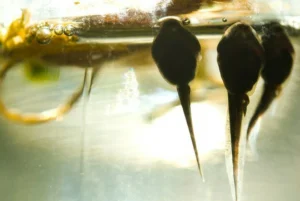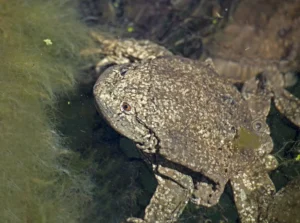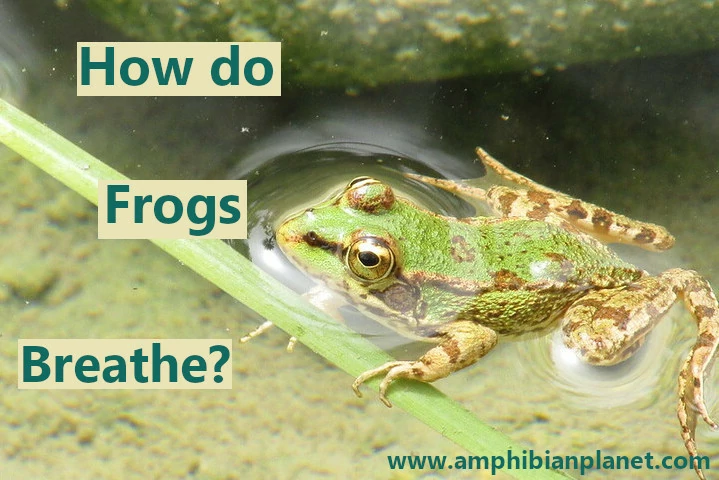Frogs are amphibians, which means they live part of their lives in water and part on land. They have different ways of breathing in each of these unique environments.
Frogs breathe using their lungs as well as through their skin and thin membranes in their mouth and throat. They start their lives as tadpoles with gills for breathing in the water. Over time, the tadpoles will lose their gills and transform into adult frogs with well-developed lungs.
When submerged in water, adult frogs hold their breath and breathe entirely through their skin.
Dissolved oxygen in the water that comes in contact with their skin is diffused into their bloodstream, and carbon dioxide is released from the bloodstream into the water (more information on that below).
Frog Tadpoles Breathe Through Their Gills
Most frogs start their lives as tiny embryos inside an egg sac. With time, tadpoles will hatch from these eggs.
Tadpoles are very different from adult frogs; this is because they’re adapted for a fully aquatic life, while adult frogs are adapted for a semi-aquatic, or mostly terrestrial life (depending on the species).
Frog tadpoles have gills on either side of their head, and a flat paddle-like tail fin to help them swim in the water.

At this stage, frog tadpoles breathe in the water through their gills, just like fish.
The gills have thin membranes and a network of blood vessels. These membranes absorb dissolved oxygen from the water and move it into the bloodstream.
At the same time, carbon dioxide from the bloodstream passes out through the membranes, and into the water
Apart from their gills, tadpoles also breathe through their skin. Dissolved oxygen in the water that comes in contact with their skin is diffused into their bloodstream, and carbon dioxide is released from the bloodstream into the water.
Tadpoles also have lungs to Breathe Air
Tadpoles sometimes live in water with low oxygen levels – where their gills (and skin) cannot absorb sufficient oxygen. This means they also need to breathe air. For this reason, most tadpole species also develop functional lungs in addition to their gills.
When they first hatch, the tadpoles are too feeble to break through the water’s surface for a gulp of air. To get around this, they “bubble-suck”.

To do this, they first stick their open mouths to the underside of the water’s surface. They then open their jaws wide and suck at the water’s surface. Doing this creates an air pocket that they can pinch off by quickly closing their jaws.
After they close their mouth, a portion of the fresh air bubble is forced down into their lungs
Since the tadpoles are tiny, they usually cannot absorb the entire air bubble, and the excess is burped out as a small bubble, after which it floats back up to the water’s surface.
Once the tadpoles get bigger, they will be strong enough to break through the water’s surface for a gulp of air.
Tadpoles Grow Into Adult Frogs
After a few months, to as long as three years in some species, the tadpoles will go through a process known as metamorphosis and transform into adults.

During metamorphosis, the tadpoles lose the features that help them live in the water and develop features more suitable for living on land:
- They lose their gills, and their lungs enlarge and develop further
- The tail shortens and is eventually absorbed into the body
- They develop strong legs for moving on land
Once metamorphosis fully is complete, the tadpoles are now young frogs and will leave the water to live on land. These young frogs will grow and mature into adults over time.
Since most frogs are semi-aquatic, they will still occasionally return to the water to soak, swim, or mate and lay their eggs.
Adult Frogs Breathe Using Their Lungs
Adult frogs breathe air using their lungs. They take air through their nostrils, and down into their lungs.
However, their lungs are quite primitive when compared to our own. They do not have diaphragms to push air into the lungs as we do. Instead, they rely on a process known as “buccal pumping.”
How Buccal Pumping Works
This is basically a process of moving air in and out of the lungs through the use of the mouth and throat muscles.

To breathe in, the frog will lower the floor of its mouth, which causes the throat to expand. Air then rushes into the throat, through the mouth, and through the open nostrils.
The frog will then close its nostrils, and raise the floor of its mouth, which causes the throat to contract, and pushes the air into the lungs.
Once the air is in the lungs, oxygen from the air is then absorbed into the frogs’ bloodstream. At the same time, carbon dioxide from the bloodstream is diffused into the air.
To breathe out, the frog will lower the floor of its mouth, which causes the throat to expand and draws the air from the lungs, and into the mouth. It will then open its nostrils, and raise the floor of its mouth, to push the air out of the nostrils.
They Also Breathe Through Their Skin
As earlier mentioned, frog lungs are quite primitive when compared to our own. They usually can not give a frog all the oxygen it needs. For this reason, frogs can also breathe through their skin and thin membranes in their mouth and throat to get extra oxygen.
The skin is made up of thin membranous tissue that is highly permeable to water and contains a large network of capillaries and other blood vessels close to the surface.
The thin membranous skin allows oxygen from the air to be absorbed into the bloodstream via diffusion. At the same time, carbon dioxide from the bloodstream passes through the skin and membranes and is diffused into the air.
This process of “skin breathing” known as cutaneous respiration is very similar to what happens inside our lungs.
To efficiently breathe, frogs have to keep their skin constantly moist by secreting a mucous coating. They can only absorb oxygen through their skin if the skin stays moist. If it dries up, they can suffocate and die.
In some frog species, cutaneous respiration is so efficient that it is their main way of breathing. For example, the Titicaca water frog is an aquatic frog species with wrinkled skin.
This frog’s excessive amount of skin makes it look rather as if it were wearing an oversized wet suit. But it performs a very important function– it provides a bigger surface area to use for cutaneous respiration.
For this reason, Titicaca water frogs have greatly reduced lungs – less than one-third the size that would be expected of other frog species of the same body size.

Because of their large skin surface area, these frogs mainly breathe through their skin, and only occasionally use their lungs. In fact, they can stay for several days without using their lungs.
How Do Frogs Breathe Underwater?
When submerged, frogs can not use their lungs to breathe air. For this reason, they breathe underwater entirely via cutaneous respiration. Dissolved oxygen in the water is absorbed through their skin and into the bloodstream via diffusion, and carbon dioxide is released from the bloodstream into the water.
However, this method of breathing does not give them all the oxygen they need, so they can only be underwater for a limited time before they have to resurface to breathe with their lungs.
Exactly how long a particular frog can stay underwater depends on; how much oxygen it can absorb from the water through its skin, vs how much oxygen its body needs for metabolism.
This is usually affected by: the oxygen content of the water, the temperature, species, and how active the frog is.
1. Oxygen Content of the Water
Frogs can stay submerged in water with a high oxygen content for much longer than they can in water with low oxygen content.
Many things influence how much oxygen there is in a particular body of water.
For instance, fast-flowing or ‘stirred up’ water generally contains more oxygen than still water. This is because oxygen from the air is dissolved in water at its surface, mostly through turbulence (for example waves, riffles, water tumbling over rocks, etc).
In still water, oxygen only dissolves on the water’s surface, so the deeper you go into the water the less oxygen there is.
Additionally, aquatic plants and algae also affect the oxygen content of water. During the daylight hours, they produce oxygen through photosynthesis and release it into the water.
At night, they will use up dissolved oxygen in the water via aerobic respiration and release carbon dioxide into the water.
Also, water with lots of decaying plants will have a lower oxygen content. This is because the bacteria responsible for the process of decomposition use oxygen and release carbon dioxide into the water, reducing the oxygen content of the water.
2. The Water Temperature
Frogs are ectothermic (cold-blooded) animals, so the environmental temperatures will affect their rate of metabolism. At higher temperatures, they will have a higher metabolic rate, meaning they have a greater oxygen demand.
At lower temperatures, the opposite is true. Frogs will have a lower metabolic rate meaning they have a lower oxygen demand.
Also, Cold water can hold more dissolved oxygen than warm water. This means the oxygen content of the water will be higher when the temperatures are low.
All this combined means frogs can stay submerged at lower temperatures for much longer than they can at warmer temperatures.
3. The Frog Species
Tadpoles have gills that provide a very large surface area to absorb lots of oxygen from the water. However, as adults, frogs do not have gills, so how much oxygen they can absorb from the water depends on their skin surface area.
Some frog species have a very large skin surface area and are better at absorbing oxygen from the water than others.
For example, the very large skin surface area Titicaca water frogs have means they do not need to surface regularly to breathe air. They can stay submerged for several days in water with a high oxygen content.
Their very large skin functions in a manner that is comparable to gills. Sometimes, they bob up–and–down to allow more water to pass by their large skin folds.
4. How Active the Frog Is
Activity affects how much oxygen the body needs. Think about it, when we are running or jogging, we breathe heavier and in much quicker breaths than when we are at laying on the couch.
For frogs, this is also true. They will have a higher oxygen demand when they are very active in the water (escaping a predator for example), and a lower oxygen demand when they are inactive.
For this reason, frogs will be able to stay underwater when at rest for much longer than when they are active.
The Frog Without Lungs
The endangered Bornean Flat-Headed frog found in Indonesia is the only currently known species of frog that does not have any lungs at all! It breathes entirely via its skin, just like many lungless salamanders.

This aquatic frog lives in cold, fast-moving rivers that provide a rich supply of oxygen and most likely lower the frog’s metabolic rate. So to the frog, oxygen is in high supply and low demand.
Also, the flattened body and head (which gives this frog its name) give its skin a large surface area for absorbing oxygen from the surrounding water.
Frogs Do Not Need as Much Oxygen as We Do
As earlier mentioned, frogs are ectothermic (cold-blooded) animals, which means they can not control their body temperature. Instead, their body temperature changes with that of their surroundings.
This is in contrast to endothermic (warm-blooded) creatures, like humans, which can maintain a constant body temperature by producing their own internal, body heat.
To make this heat, warm-blooded animals need food and oxygen. When the temperatures get colder, they will need more oxygen and more energy to produce body heat.
Since frogs are cold-blooded, they do not use any oxygen to generate internal body heat. This means, their oxygen needs are not as high as those of warm-blooded animals.
In the winter, frogs will brumate (hibernate) to protect themselves from the freezing temperatures. During brumation, their heart rate, breathing rate, and overall metabolic rate will dramatically drop.
Brumating frogs will have extremely low oxygen needs because their bodies use very little energy.
Frequently Asked Questions:
How do frogs breathe on land?
When on land, frogs breathe using their lungs. However, their lungs are quite primitive, so they also breathe through their skin and thin membranes in their mouth and throat (cutaneous respiration) to get extra oxygen. When at rest, they can most of the oxygen they need via cutaneous respiration.
How do frogs breathe in the water?
When in the water, frogs cannot breathe using their lungs, so they hold their breath and breathe entirely through their skin. Dissolved oxygen in the water is absorbed through their permeable skin and into their bloodstream via diffusion, and carbon dioxide is diffused into the water.
How do frogs breathe through their skin?
Frogs have skin consisting of thin membranous tissue that contains a large network of capillaries and other
blood vessels close to the surface. The oxygen that comes in contact with their skin is absorbed into the bloodstream via diffusion. At the same time, carbon dioxide from the bloodstream passes through the skin and is diffused into the air.
To efficiently breathe through their skin, frogs keep it constantly moist by secreting a mucous coating. If their skin dries out, they can suffocate, which can be fatal.


